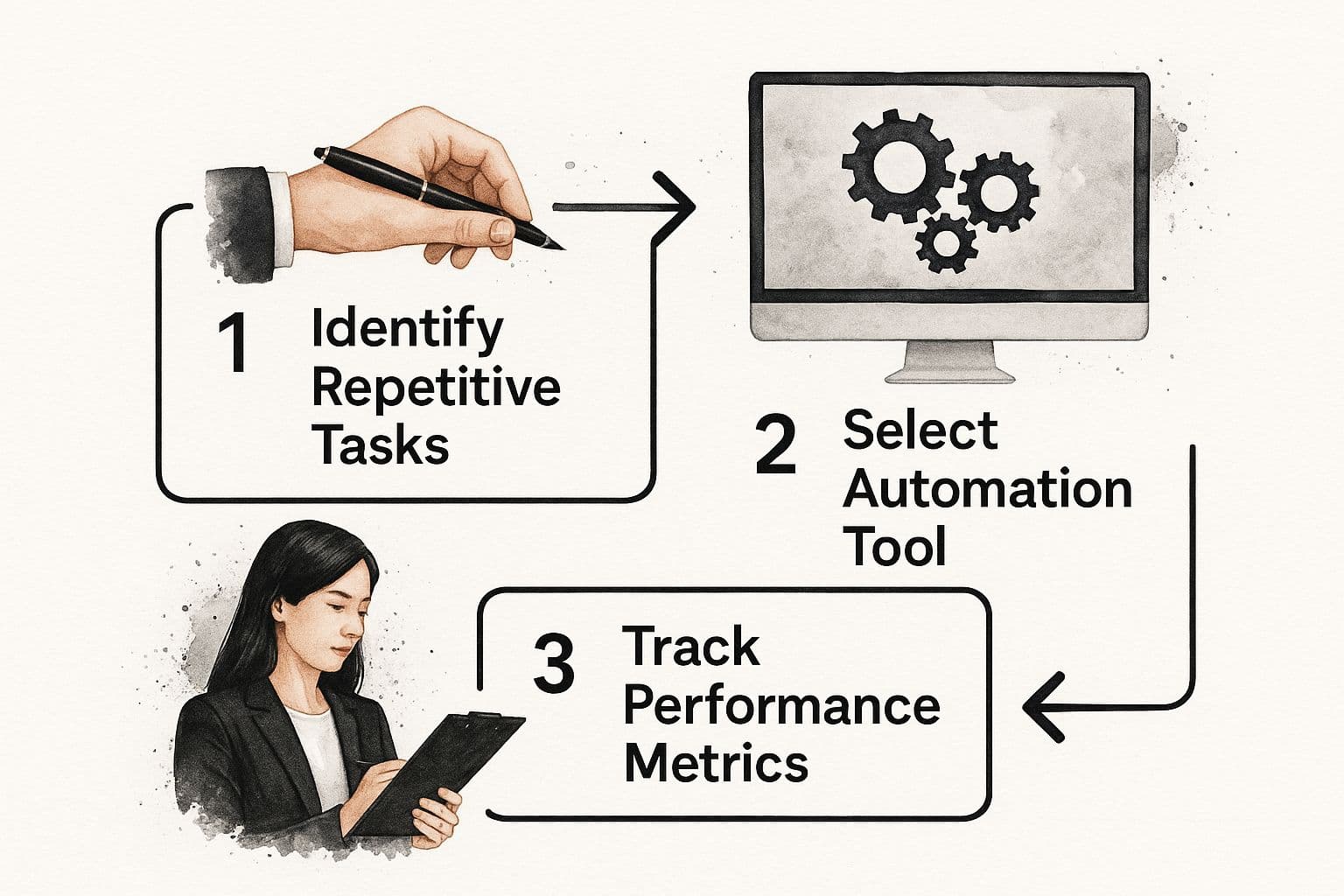Discover how workflow automation for small business can boost efficiency, cut costs, and drive growth. Your step-by-step guide to implementation and tools.
July 16, 2025 (4mo ago)
Workflow Automation for Small Business A Complete Guide
Discover how workflow automation for small business can boost efficiency, cut costs, and drive growth. Your step-by-step guide to implementation and tools.
← Back to blog
For a small business, workflow automation isn't just a buzzword**—it's a powerful way to organize tasks, slash errors, and get valuable time back. It takes the chaotic, manual parts of your day and turns them into smooth, intelligent systems. This gives you a real competitive edge, and you don't need a massive budget to make it happen.
Why Automation Is Your New Competitive Edge
Think about navigating a new city with a big, foldable paper map. You’re constantly stopping, unfolding it, trying to find where you are, and figuring out the next turn. It gets the job done, eventually, but it’s slow, full of potential mistakes, and demands all of your attention. Now, imagine using a GPS. You get clear, real-time directions, it automatically reroutes you around traffic, and you can just focus on driving.
That's the perfect way to think about workflow automation for a small business. Juggling endless email chains, disconnected spreadsheets, and a sea of sticky notes is just like using that paper map. It’s a constant struggle to keep everything organized and moving. Automation is your business's GPS.
From Manual Chaos to Digital Command
Let's be honest, many small businesses run on a kind of organized chaos. Critical information is often trapped in one person's inbox or a forgotten spreadsheet. This manual approach isn’t just inefficient; it’s risky. One missed email or a simple data entry mistake can snowball into an unhappy customer, a blown deadline, or lost revenue.
Workflow automation isn't about replacing your team with robots. It’s about giving them a digital command center for all the moving parts of your operation. It’s a smarter way to work. By using workflow management software as a central hub, you can organize tasks, minimize mistakes, and give your team’s productivity a serious boost. Instead of wrestling with outdated methods, these tools help manage everything from following up with new leads to handling invoices, setting you up for smarter growth. You can discover the top ways small businesses are automating processes and see the impact for yourself.
The core idea is simple: Let technology handle the repetitive, so your team can handle the strategic. This frees up your most valuable resource—human brainpower—to focus on innovation, customer relationships, and actually growing the business.
Gaining a True Advantage
In the past, only large corporations could afford the systems needed for this level of efficiency. Automation completely levels the playing field. It helps you standardize your processes, which means every customer gets the same great experience and every project follows the same proven steps. That kind of consistency is what builds trust and a rock-solid brand reputation.
So, what does this look like in the real world? The table below gives you a quick snapshot of how everyday tasks change when you switch from manual to automated workflows.
Manual vs. Automated Workflows At a Glance
| Task | Manual Process (The Old Way) | Automated Process (The Smart Way) |
|---|---|---|
| Client Onboarding | Manually send welcome email, create project folder, set up invoice, and add to CRM. | Contract signing triggers an automated sequence: a welcome email is sent, a project folder is created, and an invoice is generated instantly. |
| Social Media | Log in to each platform daily to post content. It's time-consuming and easy to forget. | Schedule an entire month of posts in a single session. The system posts everything for you at the optimal times. |
| Invoicing | Create and send invoices one by one. Manually track payments and send awkward follow-up emails for late payments. | Invoices are generated automatically. The system sends polite, scheduled reminders for upcoming and overdue payments, improving cash flow. |
| Lead Nurturing | Try to remember to follow up with new leads via email. Inconsistent and hard to track. | A new lead from your website form is automatically added to an email sequence that sends helpful information over several weeks. |
As you can see, the difference is night and day. Automation eliminates the tedious, error-prone tasks that drain your team's energy, allowing everyone to focus on what truly matters. It's about working smarter, not harder.
The Real-World Impact of Automating Your Business

So, we've talked about what workflow automation is, but let's get to the heart of the matter. As a small business owner, your time and money are precious. Any new system has to answer one simple question: What’s in it for me? The real value of automation shows up when it solves the very problems that keep you up at night—employee burnout, operational friction, and the struggle to grow without everything falling apart.
Think about it. How many hours does your team sink into mind-numbing data entry, chasing down late payments, or scheduling social media posts? These aren't just tedious chores; they actively drain morale and are a fast track to burnout. When your best people are bogged down by repetitive work, their energy for creative thinking, smart problem-solving, and genuine customer engagement plummets.
This is precisely where automation steps in, not just as a tool for efficiency, but as a genuine boost to your team's well-being.
Boosting Productivity and Employee Satisfaction
By handing off the routine, predictable tasks to software, you empower your employees to focus on what humans do best. This shift doesn’t just make your business run smoother; it makes for more interesting and fulfilling jobs. And the numbers back this up, loud and clear.
It’s been shown that a staggering 94% of companies are still bogged down by repetitive tasks. But for those that have embraced automation, it has improved job quality for 90% of knowledge workers and boosted their productivity by a massive 66%.
This is more important than ever. With 68% of employees feeling overwhelmed by their workload, automation becomes an essential strategy for preventing burnout and keeping your team afloat. A happier, more engaged team is a more productive one. It's that simple. Better service, smarter ideas, and a healthier bottom line all follow. To see how this plays out in practice, you can explore how businesses are using AI workflow automation to boost business efficiency.
The key thing to remember is that automation isn’t about replacing people. It’s about elevating their roles so they can apply their unique skills where it matters most. That’s the bedrock of a strong, competitive business.
Creating a Foundation for Scalable Growth
For most small businesses, growth feels messy. The manual processes that worked for your first ten customers start to buckle under the weight of a hundred. This leads to dropped balls, inconsistent service, and bottlenecks that stall your momentum.
Automation builds the solid framework you need to grow smoothly and predictably. Here’s how it works:
- Standardized Processes: Automation ensures that every new client is onboarded, every project is kicked off, and every support request is handled the exact same way, every single time. This consistency is what builds trust and makes you look like a pro.
- Reduced Operational Costs: Fewer manual errors mean less time and money wasted on fixing mistakes. It makes your entire operation leaner and more profitable from the inside out.
- Drives Digital Maturity: You can't compete today without a solid digital game plan. A full 83% of IT leaders see workflow automation as a critical part of their digital strategy, with nearly half of all businesses actively implementing it to cut down on manual work.
By automating your core operations, you're building a business that can handle more—more customers, more orders, more projects—without overwhelming your team or sacrificing quality. It's the difference between building on sand and building on solid rock.
Identifying Your First Automation Opportunities

It’s a common misconception that powerful automation is only for big corporations with huge IT budgets. The reality is quite the opposite. As a small business, you have a secret weapon: agility. You can make decisions, test new tools, and see the results almost instantly, without wading through layers of red tape. This puts you in a perfect spot to even the odds and compete on efficiency.
While larger companies get tangled in legacy systems and slow approvals, you can implement new workflows with incredible speed. This means you can standardize your key processes, deliver a consistently great customer experience, and slash operational costs much faster than your bigger competitors. It’s not about just keeping up; it’s about using your size to get ahead.
Finding Your Starting Point
So, where do you begin? The best place to start is with the tasks that are both mind-numbingly repetitive and essential to your business. Think about those "if only" tasks—the ones you know are important but drain your time, like following up with every new lead or spending an entire afternoon creating invoices. These are your goldmines for automation.
Start by looking for patterns in your daily and weekly routines. What are the things you or your team do over and over again? Pinpointing these is the first, most critical step. Our guide on how to automate repetitive tasks offers a great framework for identifying and prioritizing these opportunities for the biggest impact.
The goal isn't to automate everything at once. It's to find one or two high-impact workflows that, once automated, will free up significant time and mental energy for you and your team.
High-Impact Areas for Quick Wins
Certain parts of your business are practically begging for automation and offer a quick, noticeable return on your investment. Marketing and sales, for example, are packed with repeatable activities that are perfect for your first project. Automating things like lead nurturing emails or social media scheduling can directly fuel your growth without demanding more of your time.
The numbers back this up. Smaller businesses often see even greater success with automation than large corporations, boasting a 65% success rate compared to 55%, largely because they can move so quickly. Consider this: companies using automation have boosted their lead quantity by 80% and seen qualified leads jump by an incredible 451%. Even something as simple as automating an email workflow can double lead generation.
To help you spot these chances in your own business, here’s a look at common functions and the high-value tasks within them that are ripe for automation.
Key Automation Opportunities for Small Businesses
| Business Function | High-Impact Automation Task Example | Primary Benefit |
|---|---|---|
| Sales | Automatically send follow-up emails to new leads after a set time. | Increased lead conversion, consistent communication |
| Marketing | Schedule social media posts to publish across multiple platforms. | Saves time, maintains brand presence |
| Customer Service | Create auto-responses for common support questions. | Faster response times, improved customer satisfaction |
| Finance | Send automated reminders for overdue invoices. | Better cash flow, reduced administrative work |
| Operations | Automatically assign new tasks to team members in a project tool. | Clear accountability, smoother project execution |
These examples are just the beginning. Once you start looking, you’ll see opportunities to free up time and reduce errors everywhere.
A Small Business Story
Let's look at a real-world example. Imagine a small e-commerce shop run by a team of three. They were drowning in manual tasks: personally answering every customer email, updating inventory by hand after each sale, and sending out shipping notifications one by one. They were so bogged down just running the business that they had zero time for marketing.
They decided to make a change with automation. First, they set up automated email replies for the most common customer questions. Next, they connected their sales platform to their inventory system, so stock levels updated in real time. Finally, they automated the shipping notifications.
The result? They reclaimed 15 hours per week, dramatically cut down on costly errors, and finally had the bandwidth to focus on growing their brand. That’s the real-world power of workflow automation for a small business.
Your Step-by-Step Automation Implementation Plan
Alright, let's move from theory to action. This is where you’ll see the real value of workflow automation for small business take shape. Don’t worry—implementing automation isn’t some massive IT project that will take months. Think of it as a series of smart, manageable steps designed to build momentum and give you some quick wins right out of the gate.
This roadmap will guide you from your first idea all the way to a fully functioning automated process. The key is to start with what’s right in front of you: the small, repetitive tasks that drain your team's energy day after day.
Step 1: Identify and Prioritize Repetitive Tasks
Before you can automate anything, you need a clear target. Start by simply observing your daily operations. What are the things you and your team do over and over again? Those are your best candidates.
Look for tasks that are:
- Time-Consuming: Think about things like manual data entry or compiling weekly reports. They take up a lot of hours but don't require much strategic thought.
- Rule-Based: These are processes that follow a clear "if this, then that" logic. Onboarding a new client, for instance, almost always follows the same predictable sequence of steps.
- Prone to Human Error: Simple mistakes in tasks like invoicing or updating inventory can have surprisingly costly consequences. Automation brings precision and consistency.
Once you have a list, it's time to prioritize. Pick one or two tasks that offer the biggest bang for your buck—the highest impact for the lowest effort. A great first project is often one that will free up a noticeable chunk of time or solve a persistent, frustrating bottleneck.
Step 2: Map Your Current Workflow
With a target task in mind, the next step is to understand it inside and out. You can't improve what you can't see. Take the process you’ve chosen and map out every single step, from start to finish.
A simple flowchart or even just a bulleted list on a whiteboard is perfect for this. The goal here is detail. Note who is responsible for each step, what information they need to do their part, and where things typically get stuck or delayed. This map not only clarifies the process but often reveals hidden inefficiencies you can fix along the way.
This mapping stage is crucial. It becomes the blueprint for your automation. By defining the exact path a task takes, you’re creating the clear instructions your automation tool will need to execute it flawlessly.
Step 3: Choose the Right Automation Tools
Now for the fun part: picking your tools. The market for automation software is huge, but you can cut through the noise by focusing on your specific needs. Look for platforms that are user-friendly, can grow with your business, and integrate smoothly with the software you already rely on, like your email client or accounting program.
All-in-one platforms like Fluidwave are often ideal for small businesses because they offer a central hub for managing and automating all sorts of tasks. Of course, there are also specialized tools for very specific functions. For example, if you're focused on sales, guides on LinkedIn automation for small businesses can offer targeted advice.
The core steps are straightforward: find the task, pick the tool, and track the results.

This simple flow highlights the logical path from spotting an opportunity to measuring your success.
Step 4: Build and Test Your First Automated Workflow
With your process mapped and your tool selected, it’s time to build. Most modern tools use a simple drag-and-drop or trigger-and-action system, which means you don't need to be a coder to get started. You'll define a trigger (like "a new form is submitted on my website") and then set a corresponding action (like "add the contact to my email list and send a welcome message").
Once it's built, test it thoroughly. I can't stress this enough. Run through the process several times using sample data to make sure it works exactly as you expect. This testing phase is your quality control—it’s where you catch any glitches before the workflow goes live and affects real customers or your internal team.
Step 5: Monitor and Optimize for Continuous Improvement
Automation isn't a "set it and forget it" magic bullet. Once your workflow is up and running, keep an eye on its performance. Are you actually seeing the time savings you hoped for? Have errors gone down?
Check in on your automated processes regularly and, most importantly, get feedback from your team. You’ll almost certainly find small ways to tweak and improve them over time. This cycle of building, monitoring, and optimizing is what turns a simple automated task into a powerful, long-term asset for your business.
Choosing the Right Automation Tools for Your Business

Okay, you’ve identified the prime spots in your business that are ripe for automation. Now comes the exciting part: picking the software to make it all happen. The sheer number of options on the market can feel overwhelming, but here's the secret: finding the perfect fit isn't about getting the tool with the most bells and whistles. It's about how well it solves your specific problems.
Think of it this way. You wouldn't buy a giant semi-truck for your daily commute, and you definitely wouldn't try to haul lumber in a two-seater sports car. The best vehicle is the one that fits the job. The same logic applies to workflow automation for a small business—the right tool is the one that clicks with your processes, your team, and your vision for growth.
Understanding the Different Types of Tools
Automation software generally comes in a few different flavors. Knowing the difference will help you cut through the noise and narrow your search in a big way.
-
Task-Specific Apps: These are the specialists. They do one thing and do it exceptionally well. Think of social media schedulers, email marketing platforms, or bookkeeping software that sends invoices for you. They’re fantastic for solving a single, nagging pain point.
-
Integration Platforms (Connectors): Tools like Zapier or Microsoft Power Automate are the ultimate connectors. They act as a bridge between the apps you’re already using. For instance, they can automatically add a new lead from your website form to a spreadsheet, connecting two systems that otherwise wouldn't talk to each other.
-
All-in-One Platforms: Then you have solutions like Fluidwave, which pull project management, task automation, and team collaboration into one unified system. These are perfect for small businesses that want to create a central command center for their operations instead of constantly switching between different apps.
Key Criteria for Selecting Your Software
Now that you know what's out there, you can start evaluating your options based on what truly matters for your business. It's easy to get distracted by flashy features you'll never actually use. Instead, stay focused on these core criteria to make a smart choice. Systematically weighing these factors will lead to faster decision making and a lot more confidence in your final pick.
Your goal is to find a solution that not only solves today’s problems but can also grow with you. The last thing you want is to invest time and money into a tool you’ll outgrow in six months.
The right software should feel like a natural extension of your team—making work easier, not adding another layer of complexity.
A Practical Checklist for Evaluating Tools
To keep this process grounded, use this checklist to compare your top contenders. This approach takes the guesswork out of the equation and forces you to look at the tangible factors that will directly impact your business.
| Evaluation Criteria | What to Look For | Why It Matters for Small Business |
|---|---|---|
| Ease of Use | An intuitive interface your team can pick up quickly, without needing weeks of training. | Your team's time is precious. A tool with a steep learning curve slows everyone down and kills the whole point of getting it. |
| Integration Power | Does it connect smoothly with the software you already depend on (email, calendar, accounting, etc.)? | This prevents information from getting trapped in silos and ensures your automations can run without constant manual intervention. |
| Scalability | A platform that can handle more users, tasks, and complex workflows as your business expands. | You want to avoid the headache of migrating to a new system down the road. Look for flexible plans that can adapt as you grow. |
| Pricing Model | Clear, transparent pricing. Look for free trials, pay-per-use options, or tiers that make sense. | Predictable costs are critical for a small business. You need to be sure the value you're getting far outweighs the monthly bill. |
By taking this structured approach, you can confidently choose the best workflow automation for small business tool—one that will become a powerful engine for your company's growth.
Best Practices for Long-Term Automation Success
Getting your first automated workflow up and running feels like a major victory, and it is. But that’s just the starting line. The real, lasting benefit of workflow automation for a small business comes from weaving it into the very fabric of how you operate—making it a sustainable, ever-improving part of your company's DNA.
Success here isn't a "set it and forget it" affair. It’s about creating a culture where automation grows with you, always finding new ways to add value. To do that, you need a solid game plan built on proven best practices that keep your systems sharp, relevant, and embraced by your team.
Start Small and Scale Intelligently
One of the biggest mistakes businesses make is trying to boil the ocean—automating everything all at once. That’s a fast track to chaos, burnout, and a project that fizzles out before it ever delivers results. The smarter move? Start small with a single, high-impact process.
Find a task that's a genuine headache for your team, something repetitive and frustrating. Automating that one thing delivers a quick, visible win that gets everyone on board.
Once you’ve nailed that first automation, you have proof of concept and momentum on your side. From there, you can scale methodically. This step-by-step approach works because it:
- Builds Confidence: A quick win shows your team that automation is a helper, not a threat, sparking excitement for what's possible.
- Minimizes Risk: Fixing a small, isolated workflow is far easier than untangling a massive, complex system that’s gone wrong.
- Creates a Learning Loop: Each automation is a lesson. You learn more about your own business processes and how to make them better with every workflow you build.
Scaling this way ensures your automation strategy is built on solid ground. For a deeper dive into strategy, especially in marketing, you can find resources that help you master marketing workflow automation and apply those principles across your business.
Involve Your Team and Establish Ownership
Automation isn’t just about technology; it’s about people. Your team members are the experts on the ground. They know exactly which processes are clunky, inefficient, or ripe for improvement. Bringing them into the conversation from day one is absolutely critical for getting their buy-in.
When your staff sees automation as a tool to free them from monotony—not replace them—they become its biggest champions. After a workflow goes live, assigning clear ownership is just as important. Someone needs to be the designated point person responsible for monitoring performance, making adjustments, and keeping it humming.
A workflow without an owner is an orphan. It will inevitably become outdated or break down, eroding trust in your automation system. Clear ownership ensures accountability and long-term health.
Giving someone this responsibility is a core part of great leadership. If you're looking to improve in this area, our guide explains how to delegate tasks effectively.
Regularly Review and Refine Your Workflows
Your business doesn't stand still, so why should your automations? Markets change, customer expectations evolve, and you’ll discover better ways of working. A workflow that was a game-changer six months ago could be clunky or obsolete today.
Set a recurring calendar reminder—maybe once a quarter—to audit your automated processes. During these check-ins, ask the tough questions:
- Is this automation still saving us meaningful time?
- Are we still seeing the error reduction we expected?
- With new tools or knowledge, is there a better way to do this now?
This constant cycle of review and refinement is what separates the dabblers from the masters. It’s how you ensure your automated systems remain a powerful asset that actively drives your business forward.
Common Questions About Workflow Automation
As you think about bringing workflow automation into your business, it’s completely normal for a few questions to pop up. Making this kind of operational shift can feel like a big leap, but once you get a handle on the practical side of things, the path forward becomes much clearer. Let’s walk through some of the most common questions business owners have when they're ready to get started.
How Much Does Workflow Automation Cost?
This is usually the first thing on everyone's mind, and the honest answer is: it really depends. The cost of workflow automation isn't one-size-fits-all; it’s a spectrum. The good news is you can often start for free and then scale up as your business grows.
- Freemium Models: Many of the best tools on the market offer a free tier that's perfect for dipping your toes in the water. This is a fantastic way to automate a few simple tasks and see how it works without any financial risk.
- Per-User Pricing: Some platforms charge a monthly fee for each team member who uses the software. This can run anywhere from $10 to $50 per user, per month for really solid plans.
- Usage-Based Pricing: Other tools, particularly those that connect different apps, might charge you based on how many automated tasks you run. This model is great if your workload goes up and down.
The trick is to start small. Pinpoint your budget and identify the single most impactful process you could automate. This helps you find a cost-effective tool that delivers a return you can actually see.
Do I Need Technical Skills to Set Up Automation?
This is a huge worry for many business owners, but you can breathe easy. You absolutely do not need to be a coding wizard. Modern automation platforms were built specifically for people who don't have a technical background.
Most of these tools work on a simple "trigger-and-action" basis. You just pick a trigger (like a new customer fills out a contact form) and then tell it the action to perform automatically (like send a personalized welcome email). It’s all done through visual, drag-and-drop interfaces. If you can sketch out a basic flowchart, you have all the skills you need.
Think of it like building with LEGO bricks. The platform gives you all the pieces; you just snap them together in the right order to build the process you imagined. No programming necessary.
Which Department Should I Automate First for the Quickest ROI?
To see the fastest and most tangible return on your investment, go where the work is repetitive and follows clear rules. For most small businesses, that usually means one of two areas:
- Marketing and Sales: Automating things like lead follow-ups, social media scheduling, and email nurture sequences can directly lead to more conversations and closed deals. The ROI here is often very easy to measure.
- Administration and Finance: Think about all the time spent sending invoice reminders, onboarding new clients, or just moving data from one spreadsheet to another. Automating these tasks frees up an incredible amount of admin time and cuts down on expensive human errors.
Start where you feel the most pain. If you're tired of chasing down late payments, automate your invoicing. If promising leads are falling through the cracks, focus on your sales process first.
How Do I Get My Team on Board with New Processes?
Let's be honest, change can be a little scary. Getting your team's buy-in is absolutely essential for this to work. The secret is to position automation as a helpful assistant, not a replacement.
Start by bringing them into the conversation. Ask your team, "What are the most tedious, mind-numbing tasks on your plate that you'd love to get rid of?" When they see automation as the solution to their biggest frustrations, they'll become its strongest advocates. Show them how it frees them up for the more strategic, creative, and interesting parts of their jobs. Kick things off with a small pilot project, share the positive results, and let that success build its own momentum.
Ready to stop drowning in manual tasks and start building a more efficient business? With Fluidwave, you can automate your workflows, delegate tasks to skilled assistants, and reclaim hours of your week. Create your free account today and see the difference for yourself!
Focus on What Matters.
Experience lightning-fast task management with AI-powered workflows. Our automation helps busy professionals save 4+ hours weekly.